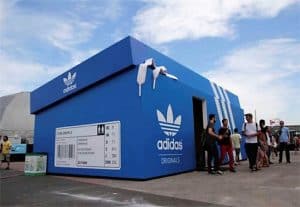No Downside to Pop-up Retail
A pop-up retail space is a temporary space that could feature a sample sale one day and host a private cocktail party the next evening.
The trend involves “popping up” one day, then disappearing anywhere from one day to several weeks later.
These temporary shops, while small, are used by companies to build interest in their product or service, and seed their product with cultural influencers.
Companies can engage customers through a unique environment that generates a feeling of relevance and interactivity. Pop ups are often used by marketers for seasonal items such as Halloween costumes and decorations, Christmas gifts and Christmas trees, or fireworks, allowing brands to capture foot traffic without committing to a long-term lease.
Pop up retail began to expand in 2002 when discount retailer Target took over a 220-foot-long boat at Chelsea Piers for a two-week stay on the Hudson River that coincided with Black Friday and extended into other genres around 2009, when the pop-up restaurant — temporary restaurants popping up in various locations — began growing in public interest and frequency.
In Pittsburgh, Project Pop Up: Downtown is a program of the Mayor’s Office, in conjunction with the Urban Redevelopment Authority, Department of City Planning and Pittsburgh Downtown Partnership
Over 90 artists, entrepreneurs, and non-profits submitted proposals to activate Downtown storefronts. Finalists were invited to “pop” into Downtown for limited engagements.
These finalists received grants with which they occupied vacant stores in Downtown throughout 2012. After the 2012 pilot year, three of the Pop Ups signed long-term leases and can still be visited today.
Project Pop Up was envisioned to be replicated and its reach includes one-time events and programs to create strong public places in Downtown Pittsburgh.
Whether it’s a non-profit endeavor, a seasonal offering or a brand building opportunity, there seems to be no downside to pop ups.


